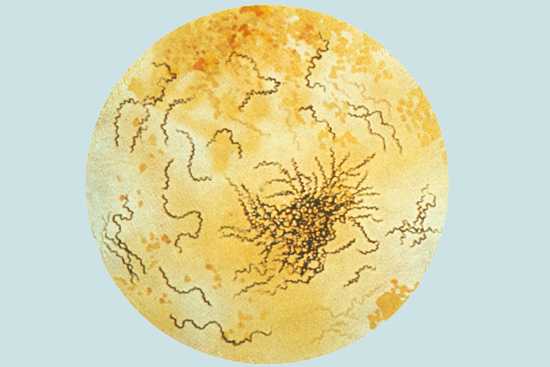AMD Projects: Tracking STD Transmission
Integrating data to understand better the transmission networks involved in the spread of infectious disease and drug resistance

Syphilis is one of many sexually transmitted diseases that can have very serious complications when left untreated.
HIV, other sexually transmitted diseases, hepatitis, and tuberculosis (TB) affect millions of people in the United States. These infections can be spread in many ways, including sexual contact, contact with bodily fluids of an infected person, and via air droplets. Even though scientists know that certain groups—such as gay and bisexual men and persons who inject drugs—are more likely to be affected, less is known about the connections between people that result in the spread of these infections. In addition, using epidemiological data alone may not always identify links between infected persons. Understanding these connections is critical to stopping the spread of disease.
CDC scientists are using genetic information (sequence data, including next generation sequencing) for the viruses and bacteria that cause these diseases, together with demographic, geographic, and clinical data—such as risk group, age, location, and health status—to understand more about how infected people are connected. Combined, this information helps scientists identify more precisely how these diseases are spreading so that outbreaks can be stopped.
These new tools, help CDC characterize transmission networks more quickly and easily to better target rapid responses to stop the spread of infection.
By improving the tools that are currently available, CDC can learn how diseases are spreading. With this knowledge, scientists can focus additional prevention tools to help protect health and reduce infections.
2017 Project Update
In the first three years of this AMD project, investigators identified and developed new computer software tools to merge large amounts of epidemiologic, genomic sequence, and clinical data to identify disease transmission networks. These easy-to-use tools also provide a visual representation of transmission networks and allow users to perform additional epidemiologic and sequence analyses in a single computer program.
As CDC applies these tools to analyze transmission networks more broadly, we expect to see benefits at the state and local levels. For example, in 2015, CDC used an early version of these tools to assist in an investigation of an HIV-1 outbreak in rural Indiana among a group of people who inject drugs. The tools allowed near real-time identification of subgroups of infected people and the combinations of risk factors that likely accelerated transmission in this small community. Knowing how the subgroups were related helped public health officials verify that this outbreak was local, rather than state-wide. This information facilitated a focused public health response within the county and demonstrated how useful these tools can be in early outbreak investigations. Study investigators also applied these tools to analyze newly acquired HIV infections in three states where partners of people from the Indiana outbreak lived. In addition, by linking to national HIV surveillance data, the application of these methods soon led to the identification of additional transmission clusters of concern across the country. These results were quickly shared with state health departments, where subsequent investigations began. Investigators identified high levels of transmission not detected by routine surveillance efforts, including evidence of cross-state transmission.
Investigators are now applying these new AMD tools to analyze other large CDC datasets to identify and characterize transmission networks involving HIV, as well as other infections, such as TB, hepatitis, and Neisseria gonorrhea. Additional work is underway to develop secure web-based and portable versions of these tools to share with state and local partners.
- Page last reviewed: March 27, 2017
- Page last updated: March 27, 2017
- Content source:


 ShareCompartir
ShareCompartir